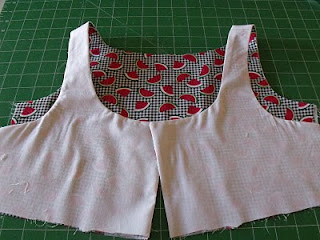I started summer sewing, Ya for me!! The top I started to make for Zoe is McCall's M5573. Reading the instruction sheet, the first thing I see I will change is the way the top is lined. Now they have instructions to sew the lining together, then sew the top together. Sew the lining in leaving the shoulders unsewn. Then you are supposed to sew the top and slip stitch the lining UGH!! This method has never worked out for me. So I will show you my method to having a lining neat on the inside.
 Sew the shoulder seams of both the fashion fabric and the lining. Then lay the pieces right side together and stitch up the front, around the neck edge and sew the armhole. You will be leaving the side seams open at this point.
Sew the shoulder seams of both the fashion fabric and the lining. Then lay the pieces right side together and stitch up the front, around the neck edge and sew the armhole. You will be leaving the side seams open at this point. Now, trim and clip your seams. I like to use pinking shears so I trim and clip all in one operation.
Now, trim and clip your seams. I like to use pinking shears so I trim and clip all in one operation. Hard to get a good picture for you. You will reach up the open back and pull the front through the shoulder.
Hard to get a good picture for you. You will reach up the open back and pull the front through the shoulder. There, you now have the lining turned. Remember the side seams are still open, so we will finish those next.
There, you now have the lining turned. Remember the side seams are still open, so we will finish those next. Meet fabric to fabric and lining to lining and sew in one continuous seam. Finish seam, press and you have a nice neat lined top.
Meet fabric to fabric and lining to lining and sew in one continuous seam. Finish seam, press and you have a nice neat lined top.









